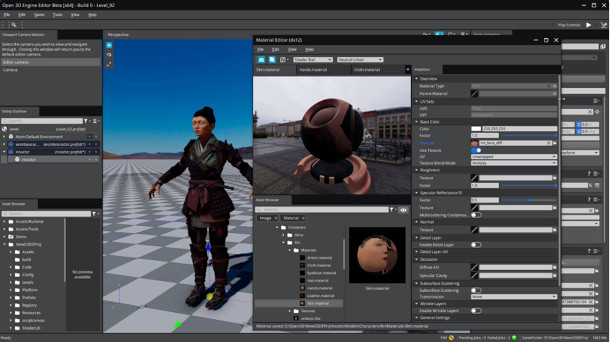AWS unveils Open 3D Engine
Amazon has unveiled the successor to Lumberyard, its free game engine and development environment.
Open 3D Engine (O3DE) is an open-source, cross-platform “AAA-capable” game engine” with a modular, SDK-like design, open-source build system and new networking stack.
It includes Atom, the firm’s new hardware-accelerated ray tracing renderer, also available open-source.
The engine, the source code for which is currently available under an Apache 2.0 licence as a developer preview, is the first release of the new Linux-Foundation-backed Open 3D Foundation.
The best bits of Lumberyard, broken down into a new modular architecture
Although Amazon Web Services’ blog post announcing O3DE describes it as the “successor to Lumberyard”, it also pitches the new engine as “very different” to the existing one.
“We kept the parts that customers loved most about Lumberyard and significantly revamped the rest,” it reads. “We aimed to build an engine that could stand the test of time in an open-source world.”
Key changes include a more modular design: “nearly every part” of the engine – including the renderer, audio subsystem and physics system – is provided as a library, making it possible to swap them out them.
Precompiled libraries do not need to be recompiled when a project changes.
The engine is also built like an SDK, making it possible to provide it in precompiled form for engine modules. When new engine versions are released, “developers can update the core Gems [modules and plugins] and will only need to resolve compile issues in the project code itself”.
An open-source build system and human-readable project files
Unlike Lumberyard, O3DE’s build system is also open-source, AWS having moved to CMake.
The change opens up the possibility of better support for tools like automated unit testing tool CTest and key plugin libraries, and native support for common IDEs including Visual Studio and XCode.
AWS has also removed all binary formats in favour of human-readable JSON files, making it possible to add or remove Gems from a project with a “single-line change to a file”.
Networking and performance improvements
Other structural changes include a new networking stack, described as featuring a “highly flexible data-driven model supporting TCP/UDP with a low latency transport layer abstracted behind a simple API”.
Performance should also be better than Lumberyard: AWs has stripped out “over 2 million lines of legacy code” and introduced new high-performance math libraries.

Includes new physically based ray tracing renderer Atom
The online documentation is currently fairly light on details about art or game design features, but one key component of O3DE that has been confirmed is Atom, AWS’s new renderer.
Announced earlier this year, Atom is a physically based renderer capable of hardware-accelerated ray tracing via DirectX 12’s DXR, Vulkan and – eventually – Metal.
You can find more details in our original story, but one new titbit from the latest blog post is that Atom supports the ACEScg colour space widely required for movie VFX work.
For physics, O3DE looks to be hardware-agnostic, or at least hardware-diverse: physics systems supported include both Nvidia’s PhysX, Cloth and Blast, and AMD’s TressFX for hair.
In-engine footage from Apocalypse Studios’ upcoming free-to-play RPG Deadhaus Sonata. The title, originally being developed in Lumberyard, is now being developed in O3DE.
So will it be more widely used than Lumberyard?
One obvious advantage of open-source tools is that they’re free, but in the case of O3DE, that isn’t actually a change: Lumberyard was free to use from its inception, including source code access.
The one stipulation was that online games had to use Amazon’s web services: you could use your own network hardware, but not services from rival cloud providers.
AWS’s blog post describes “deep integrations” between O3DE and a range of its online platforms, so those AWS cloud services haven’t gone away, although presumably their use is now optional.
Other than that, the key advantages of O3DE over Lumberyard will be its new architecture, and the greater freedom that open-source licensing affords developers.
It will be interesting to see whether either expands the user base: aside from Amazon Game Studios itself, the only major firm that we’re aware of using Lumberyard was Cloud Imperium Games – the other firms showcased on the Lumberyard YouTube channel are indie studios.
The announcement video embedded at the top of this story suggests that AWS is targeting O3DE at other industries that use real-time rendering, like automotive and product visualization.
Preston Woo, chief strategy of avatar-creation specialist Tafi, one of AWS’s technology partners, goes so far as to describe o3DE and the wider Open 3D Foundation initiative as “as revolutionary as internet 3.0” and “fundamentally transform[ing] all industries that touch 3D”.
Availability and system requirements
Open 3D Engine is available as a developer preview for Windows 10 only. Users can deploy projects to Windows 10, Linux, macOS, iOS, Android, but there is no mention of consoles in the online docs.
The source code is available under an Apache 2.0 licence. To use it, you currently have to fork the code and built it yourself. The full version will be available in “late 2021”.
Read AWS’s blog post announcing Open 3D Engine
Watch more videos about Open 3D Engine on the new O3DE website
